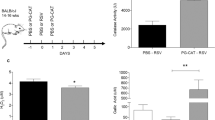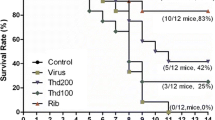Abstract
Reactive oxygen species (ROS) are believed to play a key role in the induction of lung damage caused by pneumonia and therapeutic agents that could effectively scavenge ROS may prevent or reduce the deleterious effects of influenza-induced pneumonia. In this study, we first demonstrated that human catalase could attenuate acute oxidative injury in lung tissues following influenza-induced pneumonia. Mice were infected with influenza virus H1N1 (FM1 strain) and treated with recombinant human catalase (50,000 U/kg) by inhalation. The survival time and survival rates of H1N1 induced pneumonia mice were increased by treatment with recombinant human catalase. Protective efficacy of catalase was also observed in lung histology, anti-oxidant parameters, pulmonary pathology and influenza viral titer in lungs in mice. These observations were associated with increased serum superoxide and hydroxyl radical anion scavenging capacities. This study strongly indicated that recombinant catalase might be a potential therapy for H1N1 influenza-induced pneumonia.



Similar content being viewed by others
References
Wang, C.C., K.M. Fang, C.S. Yang, and S.F. Tzeng. 2009. Reactive oxygen species-induced cell death of rat primary astrocytes through mitochondria-mediated mechanism. J Cell Biochem 107: 933–943.
Khandrika, L., B. Kumar, S. Koul, P. Maroni, and H.K. Koul. 2009. Oxidative stress in prostate cancer. Cancer Lett 282: 125–136.
Minelli, A., I. Bellezza, C. Conte, and Z. Culig. 2009. Oxidative stress-related aging: A role for prostate cancer? Biochim Biophys Acta 1795: 83–91.
Angelopoulou, R., G. Lavranos, and P. Manolakou. 2009. ROS in the aging male: Model diseases with ROS-related pathophysiology. Reprod Toxicol 28: 167–171.
Lü, Z.M., L.Y. Sang, Z.M. Li, and H. Min. 2009. Catalase and superoxide dismutase activities in a Stenotrophomonas maltophilia WZ2 resistant to herbicide pollution. Ecotoxicol Environ Saf 72: 136–143.
Ogbeyalu, E.O., E.J. George, Y.F. Zhao, L.C. Zhou, H. Yang, and Z.M. Guo. 2009. Overexpression of catalase delays G0/G1- to S-phase transition during cell cycle progression in mouse aortic endothelial cells. Free Radic Biol Med 46: 1658–1667.
Brian, J.D. 2009. Catalase and glutathione peroxidase mimics. Biochem Pharmacol 77: 285–296.
Tetsuro, Y., S. Yoshihiro, I. Toshio, N. Osamu, and R. Chisei. 2006. Silver activates mast cells through reactive oxygen species production and a thiol-sensitive store-independent Ca2+ influx. Free Radic Biol Med 40: 1949–1959.
Bhalchandra, J.K., P. Anson, and D. Ladislav. 2007. Chronic hyperbaric oxygen treatment elicits an anti-oxidant response and attenuates atherosclerosis in apoE knockout mice. Atherosclerosis 193: 28–35.
Tomochika, H., A. Shoichiro, W. Taiji, O. Shigeru, and K. Hiroyoshi. 2009. Protective effects of the complex between manganese porphyrins and catalase-poly(ethylene glycol) conjugates against hepatic ischemia/reperfusion injury in vivo. J Control Release 135: 60–64.
Grace, Y., K.H. David, Y.D. Kira, R. Julie, G.H. Paul, T.C. John, and B.L. David. 2008. Focus on FOCIS: The continuing diagnostic challenge of autosomal recessive chronic granulomatous disease. Clin Immunol 128: 117–126.
Makiya, N., H. Mitsuru, and T. Yoshinobu. 2009. Catalase delivery for inhibiting ROS-mediated tissue injury and tumor metastasis. Adv Drug Deliver Rev 61: 319–326.
Hyoudou, K., M. Nishikawa, Y. Umeyama, Y. Kobayashi, F. Yamashita, and M. Hashida. 2004. Inhibition of metastatic tumor growth in mouse lung by repeated administration of polyethylene glycol-conjugated catalase: Quantitative analysis with firefly luciferase-expressing melanoma cells. Clin Cancer Res 10: 7685–7691.
Derek, G. 2009. The 2009 H1N1 influenza outbreak in its historical context. J Clin Virol 45: 174–178.
Taubenberger, J.K., and D.M. Morens. 2008. The pathology of influenza virus infections. Annu Rev Pathol 3: 499–522.
Shi, X.L., M.Q. Feng, J. Shi, Z.H. Shi, J. Zhong, and P. Zhou. 2007. High-level expression and purification of recombinant human catalase in Pichia pastoris. Protein Expr Purif 54: 24–29.
Jin, H., S. Manetz, J. Leininger, C. Luke, K. Subbarao, B. Murphy, G. Kemble, and K.L. Coelingh. 2007. Toxicological evaluation of live attenuated, cold-adapted H5N1 vaccines in ferrets. Vaccine 25: 8664–8672.
Tao, P., M.C. Luo, R.G. Pan, D.W. Ling, S.Y. Zhou, P. Tien, and Z.S. Pan. 2009. Enhanced protective immunity against H5N1 influenza virus challenge by vaccination with DNA expressing a chimeric hemagglutinin in combination with an MHC class I-restricted epitope of nucleoprotein in mice. Antiv Res 81: 253–260.
Wang, J.X., J.Y. Zhou, Q.W. Yang, Y. Chen, X. Li, Y.A. Piao, and H.Y. Li. 2008. An improved embryonated chicken egg model for the evaluation of antiviral drugs against influenza A virus. J Virol Methods 153: 218–222.
World Health Organization Weekly Epidemiological Record. 2009. Global influenza surveillance network: laboratory surveillance and response to pandemic H1N1 2009. 84: 361–372.
Fraser, C., C.A. Donnelly, S. Cauchemez, W.P. Hanage, M.D. Van Kerkhove, T.D. Hollingsworth, J. Griffin, R.F. Baggaley, H.E. Jenkins, E.J. Lyons, T. Jombart, W.R. Hinsley, N.C. Grassly, F. Balloux, A.C. Ghani, N.M. Ferguson, A. Rambaut, O.G. Pybus, H. Lopez-Gatell, C.M. Alpuche-Aranda, I.B. Chapela, E.P. Zavala, D.M. Espejo Guevara, F. Checchi, E. Garcia, S. Hugonnet, and C. Roth. 2009. Pandemic potential of a strain of Influenza A (H1N1): Early findings. Science 324: 1557–1561.
Taia, T.W., and P. Peter. 2009. Unraveling the mystery of swine influenza virus. Cell 137: 983–985.
Imai, Y., K. Kuba, G.G. Neely, R. Yaghubian-Malhami, T. Perkmann, G. van Loo, M. Ermolaeva, R. Veldhuizen, Y.H.C. Leung, and H.L. Wang. 2008. Identification of oxidative stress and toll-like receptor 4 signaling as a key pathway of acute lung injury. Cell 133: 235–249.
Takayuki, N., K. Shigeru, Y. Fumiyoshi, and H. Mitsuru. 2007. Efficient protection by cationized catalase against H2O2 injury in primary cultured alveolar epithelial cells. J Control Release 121: 74–80.
Dympna, M.P., E.Z. Tahereh, R. John, O.A. Ali, J. Mohammad, U. Luis, J.M. Edmund, and L.M. Lin. 2007. Antioxidants preserve macrophage phagocytosis of pseudomonas aeruginosa during hyperoxia. Free Radic Biol Med 42: 1338–1349.
Kim, D.W., H.J. Jeong, H.W. Kang, M.J. Shin, E.J. Sohn, M.J. Kim, E.H. Ahn, J.J. An, S.H. Jang, K.Y. Yoo, M.H. Won, T.C. Kang, I.K. Hwang, O.S. Kwon, S.W. Cho, J. Park, W.S. Eum, and S.Y. Choi. 2009. Transduced human PEP-1-catalase fusion protein attenuates ischemic neuronal damage. Free Radic Biol Med 47: 941–952.
Jian, W., G.H. James, and C. Nipavan. 2009. Antioxidant enzyme gene transfer for ischemic diseases. Adv Drug Deliver Rev 61: 351–363.
Acknowledgments
This work was supported by grants from the National Nature Science Foundation of China (No: 30572276, 2006–2008), Shanghai Science and Technology Funds (No: 09XD1421800, 06DZ22906) and National Science and Technology Major Project for Drug Discovery of Ministry of Science and Technology of China (2009ZX09303).
Author information
Authors and Affiliations
Corresponding authors
Additional information
Xun-long Shi and Zhi-hui Shi contributed equally to this work.
Rights and permissions
About this article
Cite this article
Shi, Xl., Shi, Zh., Huang, H. et al. Therapeutic Effect of Recombinant Human Catalase on H1N1 Influenza-induced Pneumonia in Mice. Inflammation 33, 166–172 (2010). https://doi.org/10.1007/s10753-009-9170-y
Published:
Issue Date:
DOI: https://doi.org/10.1007/s10753-009-9170-y




